UC study introduces new technology for real-time monitoring of microalgae growth
The platform represents a major breakthrough for the biotechnology industry, enabling more effective large-scale microalgae production and more efficient management of water resources.
A study led by the Faculty of Sciences and Technology of the University of Coimbra (FCTUC), published in the journal Biosensors and Bioelectronics, presents a breakthrough solution for precise real-time monitoring of microalgae growth and the metabolites they produce, with various industrial applications.
According to the research, this new technology combines Electrochemical Impedance Spectroscopy (EIS) with three-dimensional porous electrodes, enabling the development of a probe capable of monitoring microalgae growth in real-time, as well as their production of exopolysaccharides (EPS) – natural macromolecules with emulsifying properties used in the food industry – alongside their anti-inflammatory and antioxidant activities, among others.
«We employ Lobochlamys segnis as a microalgae model system and show that growth can be continuously monitored for at least 14 days. The results indicate that the logistic growth rate obtained through EIS is similar to conventional cell counting. Furthermore, the ohmic resistance proved to be a reliable indicator for detecting the peak point of EPS production," explains Paulo Rocha, professor at the Department of Life Sciences (DCV) and researcher at the Centre for Functional Ecology (CFE).
According to the expert, this technology represents a significant advance for the biotechnology industry, allowing the optimisation of large-scale microalgae production and more efficient management of water resources. The research team, led by Paulo Rocha, includes PhD students Francisco Cotta Jr and Felipe Bacellar, CFE researchers Raquel Amaral and Diogo Correia, and Kamal Asadi, a professor at the University of Bath, UK.
The scientific article “A 3D porous electrode for real-time monitoring of microalgal growth and exopolysaccharides yields using Electrochemical Impedance Spectroscopy” is available here.
